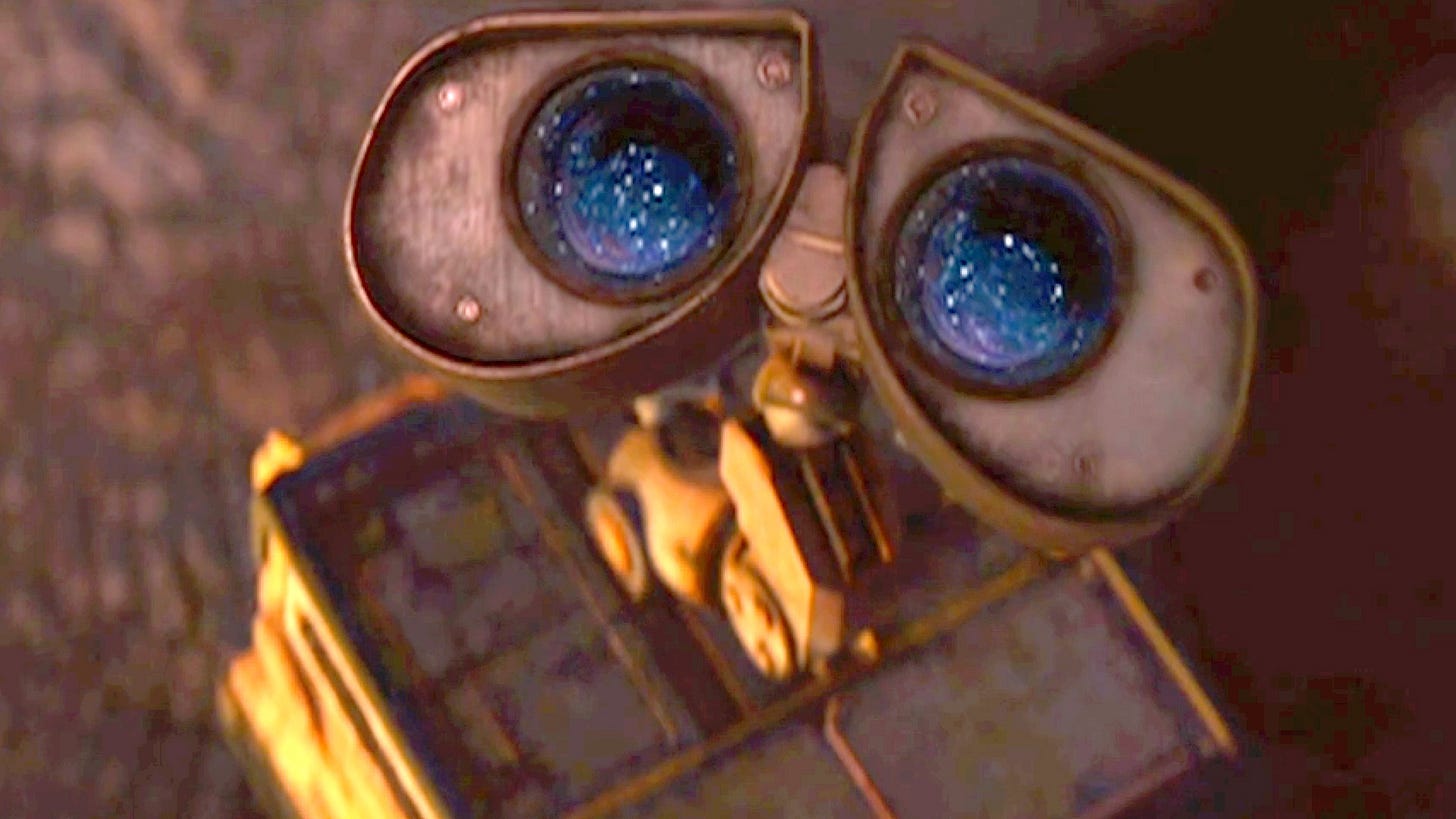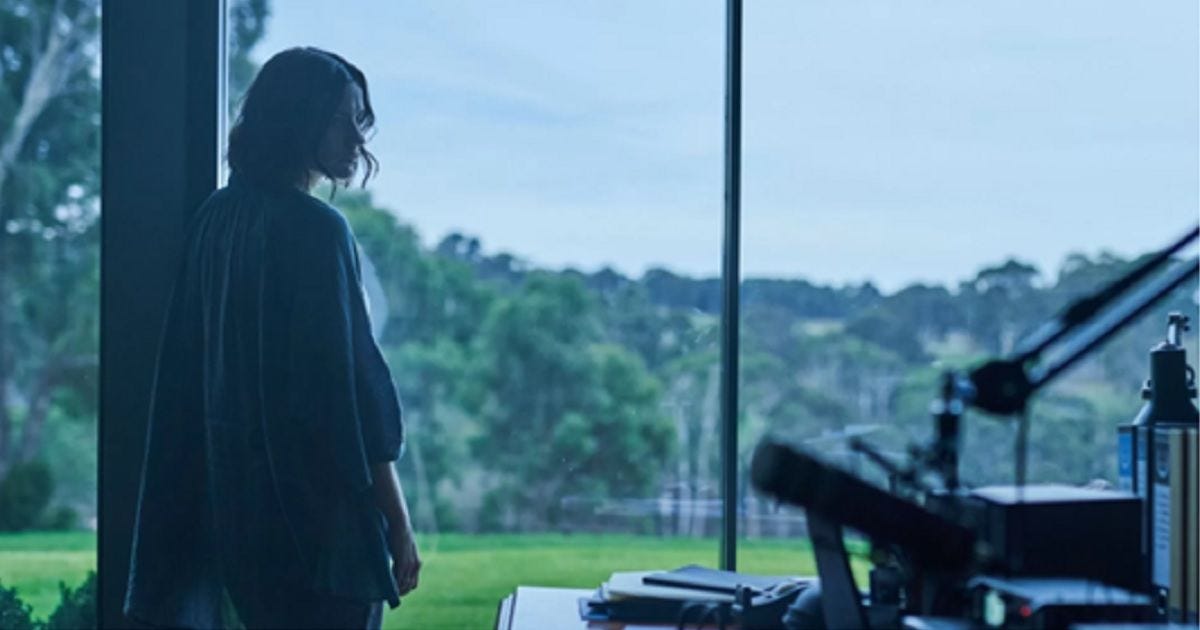The Treatment's 5-Film Progressive Workout Regimen (FilmStack Challenge #3)
Diet, exercise, and subtext; the three pillars of brainrot loss
If Ted Hope is the founding father of FilmStack, then the incandescent Sophie of That Final Scene is our charge commander, so it’s only natural that she received the first baton-pass of the end-of-month FilmStack challenge series.
No doubt playing off her recent series on the death and rebirth of cinema1 (in which she likens movie theatres to cultural gyms), Sophie tasked us all with coming up with “five films that would make an amazing ‘progressive workout’ sequence for film newbies.”
So snap on your neon spandex and grab your trustiest popcorn bowl, folks; your medius literus maximus is about to become mighty.
#1: 98 Reps of Intergalactic Loneliness (Wall-E)
I believe it was C.S. Lewis who said something along the lines of “A children’s story that only appeals to children is not a good children’s story.”
If he did indeed say that, he was correct. Even for the most analytical sticklers in the sphere (oh, hello), the understanding we create with the movies we watch could most accurately be described as a childlike magic; a magic that’s predicated upon our active curiosity towards a film and, by extension, what happens inside of us when we watch it. Kind of like how a certain trash-compacting robot is endlessly curious about love and what happens inside of him when he experiences it.
Children — who have yet to bear the burden of a world that seems to have less and less love for curiosity every day — are therefore in prime position to reap the rewards that only cinema can bestow upon us, and we must honour that youthful opportunity by being uncompromising in crafting great children’s stories for the screen.
Succeeding that, we should join them in the audience and reap those rewards for ourselves, because if I’m understanding this progressive cinematic workout correctly, the goal is to exercise — or perhaps heal — our movie-watching muscles. It makes sense, then, to start with something as fundamentally accessible and unendingly nutritious as one of the great children’s films.
Wall-E is that film, for reasons I’ll save for a dedicated post on it. Just know that, so long as you watch it with the same respect that was used to craft it, you’ll be well on your way to benefitting from cinema beyond your wildest dreams — maybe even as much as the kids in the audience.
#2: 92 Sets of the Collective Consciousness (A Ghost Story)
Alright, so you’ve just finished your great cinema appetizer in Wall-E, during which you’ve hopefully followed my advice of watching it with respect. That’s easy to do with Wall-E, whose accessible-by-design aesthetic and storytelling won’t intimidate those who aren’t used to really paying attention to movies.
This will not be the case with A Ghost Story, the 2017 supernatural drama from David Lowery. Like Wall-E, it’s meditative, meandering (complimentary), and with relatively little dialogue, and so you’ll be relying on a similar interpretive toolbox to make emotional sense of it.
Unlike Wall-E, though, A Ghost Story isn’t particularly interested in being accessible. But that’s okay, because Wall-E warmed up your “watch movies with respect” muscle so that you can use them to interrogate a heavier text like A Ghost Story.
You may become frustrated when/if the film doesn’t make sense to you, or maybe you think it’s ridiculous to have the eponymous ghost be represented by a sheet over Casey Affleck’s head. That’s okay, but that’s no excuse to quit taking it seriously; the goal isn’t to unearth some hidden understanding or submit to contrived immersion, but to create an understanding between yourself and the film.
You are not trying to conquer the film, and the film is not trying to conquer you — you and the film are peers in this exchange.
You will be thrown exactly one tangible lifeline in the form of a midpoint monologue about the collective consciousness; switch gears to internalize the words, and then carry them with you through the rest of Lowery’s images. See what changes about how you watch the rest of it. Consider how it changes the way you thought about the first half of the film.
Once you’ve done all that, it’s time for…
#3: Active Recovery with Lily Sullivan (Monolith)
Monolith is a bit more traditional than A Ghost Story — there’s a hearty amount of dialogue, a hero to cheer for and stakes to cheer against, and a smattering of genre thrills.
I’ve chosen it as the workout midpoint for a few reasons. The first is that you should start to see some results by now, and while the real reward is a re/awakened love for cinema and what it can do for mind and soul, Monolith’s more traditional elements represent a return to a more casual comfort zone, which can be considered a bonus of sorts — you’ve committed to the protein, so have a bit of chocolate.
But, it’s in that very readmittance into a comfort zone that the challenge of Monolith also takes place:
Can you take what you’ve learned from Wall-E and A Ghost Story — two films that encouraged and then forced you to really pay attention — and apply it to a film like Monolith, who has somewhat loosened its grip on the proverbial leash?
Will you still bring that honest film-watching attitude to films that don’t immediately demand it of you?
And make no mistake, either; Monolith is no popcorn movie. Matt Vesely’s sci-fi thriller deals pretty heavily in questions of existentialism, ego, and the nature of truth in what’s increasingly a post-truth world. The comparative wealth of dialogue means you’ll have something sturdier to hold onto, but you’ll still need to put in the work to philosophically excavate this one.
Moreover, to allude to an earlier point I made, interpreting a quiet, visually-dense frame is much different than drawing revelations from dialogue, ditto the filmic combination of busy frame and loaded dialogue. Expect to work a wider array of muscles here.
And after Monolith, you’ll be teaming up with its legendary ancestor.
#4: Kubrick-Clarke Strength Training (2001: A Space Odyssey)
Here it is, folks; the mountain upon a mountain that you’ve heard so much about. A regular occupant of many an all-timer list (and a regular podium-placer on sci-fi all-timer lists). A definitive opus of American cinema, and yet, a film that the untrained movie watcher would nevertheless fall asleep to.
But you’re not untrained anymore. You’re here to grow into a cultural fitness freak; to turn your steady flow of Michael Bay into an infrequent cheat day while prioritizing the complex carbs of narrative and technical maturity. To deadlift mind-shattering themes instead of setting the treadmill to “A Netflix Original Film” and seeing no change in your heart rate. To introduce Yorgos Lanthimos into your palate while maintaining joy with moderated George Lucas and indie superfoods.
I have nothing left to teach you. Dive in, keep your feet on the floor, lean towards the screen, and assume no detail was left to chance. You’re gonna be on the cover of magazines, kid.
#5: Three Sets of 98 Reps of Intergalactic Loneliness (Wall-E)
“Hey! Wait a minute! You alre-” Shush. Listen.
Here’s the thing, folks; it doesn’t actually matter which order you watch these films in. In fact, it doesn’t even matter if you watch five completely different films. There’s a logic innate to my suggesting of these specific films in this specific order, yes, but the success of this progressive workout — the success of any workout, of any personal enterprise — hinges entirely on what you bring to it.
As such, the road to cinematic nutrition and cultural health lies not in what we watch, but in how we watch it.2 And now that you’ve gone on this journey from Pixar, to A24, to microbudgeted Australian genre work, all the way to the sci-fi throne that houses 2001: A Space Odyssey, why not end your workout by rewatching your entry point and seeing how much you’ve grown since you first dove into it as a light appetizer? You might just find yourself watching a whole other movie; a movie that turned out to be so much more than a light appetizer, so long as you were willing and able to see something more in it.
Indeed, cinema may quite famously be one of, if not the most collaborative artform out there, but very rarely do we acknowledge the unattached viewer’s role in completing that collaboration — the ones who experience and share the magic that they’ve wrangled with their filmic curiosity. The ones who — while everyone else is thinking nothing more than how silly and sweet this little robot is — are actively unlocking the mystery of humanity’s purpose by watching the very same screen.
This to say, take good care of those media literacy muscles; the filmmakers of the world — and the world itself — are counting on you.
Until next time!
Which, in truth, will probably affect what we watch anyway, but perhaps that only compounds my point.











Man I'm super struggling to limit to just 5 and here you are all "Haha actually just 4."
Still haven’t watched Monolith. Now I’m going to get on it.